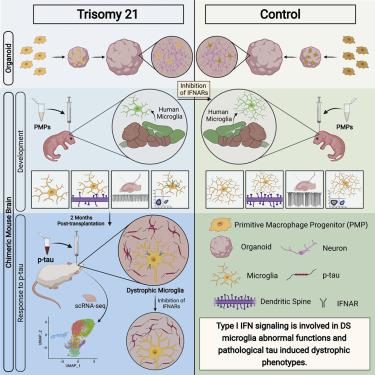Cell Stem Cell ( IF 23.9 ) Pub Date : 2022-07-07 , DOI: 10.1016/j.stem.2022.06.007 Mengmeng Jin 1 , Ranjie Xu 1 , Le Wang 2 , Mahabub Maraj Alam 1 , Ziyuan Ma 1 , Sining Zhu 1 , Alessandra C Martini 3 , Azadeh Jadali 1 , Matteo Bernabucci 2 , Ping Xie 1 , Kelvin Y Kwan 1 , Zhiping P Pang 2 , Elizabeth Head 3 , Ying Liu 4 , Ronald P Hart 1 , Peng Jiang 1

|
Microglia are critical in brain development and Alzheimer’s disease (AD) etiology. Down syndrome (DS) is the most common genetic developmental disorder and risk factor for AD. Surprisingly, little information is available on the impact of trisomy of human chromosome 21 (Hsa21) on microglial functions during DS brain development and in AD in DS. Using induced pluripotent stem cell (iPSC)-based organoid and chimeric mouse models, we report that DS microglia exhibit an enhanced synaptic pruning function, which alters neuronal synaptic functions. In response to human brain tissue-derived pathological tau, DS microglia undergo cellular senescence and exhibit elevated type-I-interferon signaling. Mechanistically, knockdown of Hsa21-encoded type I interferon receptors, IFNARs, rescues the DS microglial phenotypes both during brain development and in response to pathological tau. Our findings provide in vivo evidence that human microglia respond to pathological tau by exhibiting dystrophic phenotypes. Targeting IFNARs may improve DS microglial functions and prevent senescence.
中文翻译:

I 型干扰素信号传导导致唐氏综合症和阿尔茨海默病的人类 iPSC 模型中的小胶质细胞功能障碍和衰老
小胶质细胞对于大脑发育和阿尔茨海默病 (AD) 病因至关重要。唐氏综合症 (DS) 是最常见的遗传发育障碍和 AD 的危险因素。令人惊讶的是,关于人类 21 号染色体三体性 (Hsa21) 对 DS 大脑发育期间和 AD 中小胶质细胞功能的影响的信息很少。使用基于诱导多能干细胞 (iPSC) 的类器官和嵌合小鼠模型,我们报告 DS 小胶质细胞表现出增强的突触修剪功能,从而改变神经元突触功能。为了响应人脑组织来源的病理性 tau 蛋白,DS 小胶质细胞经历细胞衰老并表现出 I 型干扰素信号传导增强。从机制上讲,Hsa21 编码的 I 型干扰素受体IFNAR的敲低s,在大脑发育过程中和对病理性 tau 蛋白的反应中拯救 DS 小胶质细胞表型。我们的研究结果提供了体内证据,证明人类小胶质细胞通过表现出营养不良表型对病理性 tau 蛋白做出反应。靶向 IFNAR 可能会改善 DS 小胶质细胞功能并预防衰老。



























 京公网安备 11010802027423号
京公网安备 11010802027423号